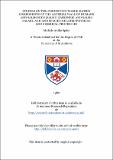Studies on the connective tissue matrix components of the arterial wall of humans and salmonids (salmo gairdneri and salmo salar): age-and species-related physical and chemical properties
Abstract
Section A of this thesis describes the non-degradative isolation procedure of elastin from the media of human thoracic aorta and the determination of its ponderal distribution as well as that of the other connective tissue matrix components in the aortic media of individuals of different ages. A cylindrical segment, free of complex atherosclerotic lesions, was resected at autopsy from each of fifty-nine descending human thoracic aortae by cutting just below the level of the first pair of intercostal arteries and 35 mm distal to this incision. In the isolated tunica media there was an age-related rise in the absolute concentration of the following components: (a) proteins and glycoproteins extractable in chaotropic agents, (b) collagen and (c) an insoluble polar protein(s) which was resistant to collagenase digestion but was solubilized by trypsin. In contrast, the absolute elastin concentration was constant at around 70 mg/cm in samples of all ages. Although after treatment with collagenase and trypsin, both the mechanical properties and amino acid composition of elastin did not vary with age, in samples tested prior to trypsin digestion the insoluble polar-protein contaminant affected the mechanical behaviour of the elastin network in a way akin to plasticisers in rubber. It is therefore suggested that the morphological changes .and stiffening observed in the ageing aortic wall are not due to degradation of its elastin network bu to variations in the supramolecular organisation of connective tissue components. Section B of this thesis describes the isolation of elastin and the determination of its distribution as well as that of collagen in the bulbus arteriosus and ventral aorta of trout (Salmo gairdneri) and salmon (Salmo salar). The isolation of elastin fibrils from these specimens did not require the use of proteolytic enzymzes as collagen and all the other components of the vessel wall were readily extracted in denaturing and reducing conditions. The arterial walls of trout and salmon are characterized by a high elastin content, with an elastin:collagen ratio exceeding 2.5:1. The elastin which display an amino acid composition highly at variance with that of the mammalian protein, is present as 250-A-diameter fibrils which have a strong affinity for electron-dense cations and which form in the intercellular matrix an isotropic reticulum. As in mammalian elastin, the fibrils can be resolved in negatively contrasted preparations into constituent primary filaments of about 25 A in diameter, aligned with an equatorial periodicity of about 55 A. The wide-angle X-ray diffraction pattern of the salmonid preparations showed broad reflections corresponding to spacings of 9.8, 4.5 and 2.2 A, similar to bovine elastin. The mechanical behaviour of the salmon preparation was characterized by a linear response to stress, with minimal hysteresis, a Young's modulus of 5.5 x 105 N m-2, and a breaking strain of 1.5.
Type
Thesis, PhD Doctor of Philosophy
Collections
Items in the St Andrews Research Repository are protected by copyright, with all rights reserved, unless otherwise indicated.

